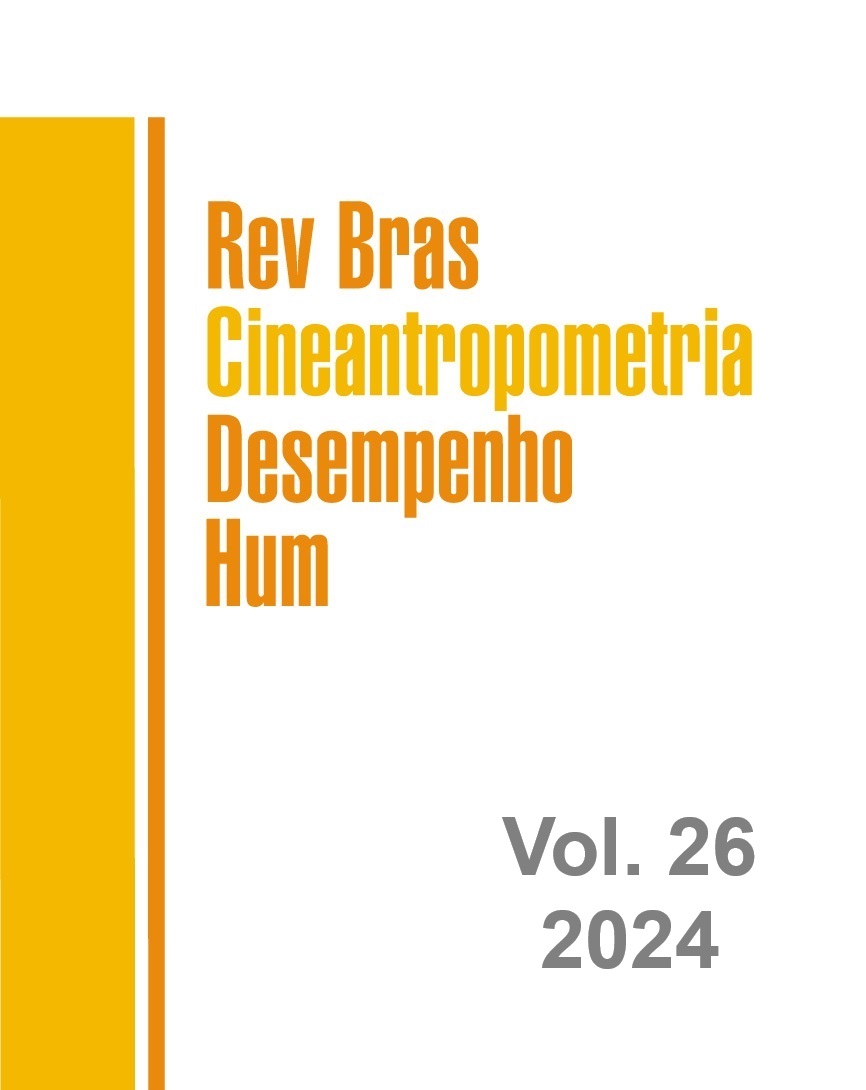A posição do cotovelo altera a força de preensão manual na doença de Parkinson?
DOI:
https://doi.org/10.1590/1980-0037.2024v26e95540Palavras-chave:
articulação do cotovelo, força muscular, Dinamômetro de Força Muscular, doença neurodegenerativa, idososResumo
O cotovelo flexionado é uma posição padronizada no teste de força de preensão manual, no entanto, a literatura mostra divergências nos valores obtidos com o cotovelo estendido. O objetivo deste estudo foi verificar se existe tal diferença em pessoas com a doença de Parkinson. Estudo transversal. Trinta e um idosos com diagnóstico clínico da doença de Parkinson realizaram 2 testes de preensão manual, o primeiro com o cotovelo estendido e o segundo com o cotovelo flexionado, com intervalo de 48 horas. Não houve diferença significativa entre as posições para a força de preensão manual (p > 0,05). Além disso, o tamanho do efeito foi insignificante (d < 0,19). Os principais resultados indicam que não houve diferença significativa entre o protocolo flexionado e o estendido, o tamanho do efeito foi negativo e muito pequeno, o que mostra que não há efeito clínico. Portanto, não há diferença entre as posições do cotovelo, recomenda-se a posição padronizada da Sociedade Americana de Terapeutas de Mão para o teste de força de preensão manual.
Referências
Orssatto LBR, Moura BM, Bezerra ES, Andersen LL, Oliveira SN, Diefenthaeler F. Influence of strength training intensity on subsequent recovery in elderly. Exp Gerontol. 2018;106:232-9.
Sirola J, Rikkonen T, Tuppurainen M, Jurvelin JS, Kroger H. Association of grip strength change with menopausal bone loss and related fractures: a population-based follow-up study. Calcif Tissue Int. 2006;78(4):218-26.
Chung KS, Ha JK, Yeom CH, Ra HJ, Lim JW, Kwon MS, et al. Are Muscle Strength and Function of the Uninjured Lower Limb Weakened After Anterior Cruciate Ligament Injury? Two-Year Follow-up After Reconstruction. Am J Sports Med. 2015;43(12):3013-21.
Volaklis KA, Halle M, Meisinger C. Muscular strength as a strong predictor of mortality: A narrative review. Eur J Intern Med. 2015;26(5):303-10.
Corcos DM, Chen CM, Quinn NP, McAuley J, Rothwell JC. Strength in Parkinson's disease: relationship to rate of force generation and clinical status. Ann Neurol. 1996;39(1):79-88.
Sayer AA, Syddall HE, Dennison EM, Martin HJ, Phillips DI, Cooper C, et al. Grip strength and the metabolic syndrome: findings from the Hertfordshire Cohort Study. QJM. 2007;100(11):707-13.
Brooks BR. Natural history of ALS: symptoms, strength, pulmonary function, and disability. Neurology. 1996;47(4 Suppl 2):S71-81.
Figueiredo IM, Sampaio RF, Mancini MC, Silva FCM, Souza MAP. Test of grip strength using the Jamar dynamometer. Acta Fisiátrica. 2007;14(2):104-110.
Ng GYF, Fan ACC. Does Elbow Position Affect Strength and Reproducibility of Power Grip Measurements? Physiotherapy. 2001; 87(2):68-72.
Massy-Westropp NM, Gill TK, Taylor AW, Bohannon RW, Hill CL. Hand Grip Strength: age and gender stratified normative data in a population-based study. BMC Res Notes. 2011;4(1):127.
Desrosiers J, Bravo G, Hebert R, Mercier L. Impact of elbow position on grip strength of elderly men. J Hand Ther. 1995;8(1):27-30.
Roberts HC, Syddall HE, Butchart JW, Stack EL, Cooper C, Sayer AA. The Association of Grip Strength With Severity and Duration of Parkinson's: A Cross-Sectional Study. Neurorehabil Neural Repair. 2015;29(9):889-96.
Fess EE. Clinical assessment recommendations. Chicago (401 N. Michigan Ave., Chicago IL 60611-4267): American Society of Hand Therapists; 1992.
Su CY, Lin JH, Chien TH, Cheng KF, Sung YT. Grip strength in different positions of elbow and shoulder. Arch Phys Med Rehabil. 1994;75(7):812-5.
España-Romero V, Ortega FB, Vicente-Rodríguez G, Artero EG, Rey JP, Ruiz JR. Elbow position affects handgrip strength in adolescents: validity and reliability of Jamar, DynEx, and TKK dynamometers. J Strength Cond Res. 2010;24(1):272-7.
Oxford KL. Elbow positioning for maximum grip performance. J Hand Ther. 2000;13(1):33-6.
Kuzala EA, Vargo MC. The Relationship Between Elbow Position and Grip Strength. American Journal of Occupational Therapy. 1992;46(6):509-12.
Kuzala EA, Vargo MC. The relationship between elbow position and grip strength. Am J Occup Ther. 1992;46(6):509-12.
Jones GR, Roland KP, Neubauer NA, Jakobi JM. Handgrip Strength Related to Long-Term Electromyography: Application for Assessing Functional Decline in Parkinson Disease. Arch Phys Med Rehabil. 2017;98(2):347-52.
Goetz CG, Poewe W, Rascol O, Sampaio C, Stebbins GT, Counsell C, et al. Movement Disorder Society Task Force report on the Hoehn and Yahr staging scale: status and recommendations. Mov Disord. 2004;19(9):1020-8.
Craig CL, Marshall AL, Sjostrom M, Bauman AE, Booth ML, Ainsworth BE, et al. International physical activity questionnaire: 12-country reliability and validity. Med Sci Sports Exerc. 2003;35(8):1381-95.
Alkurdi ZD, Dweiri YM. A Biomechanical Assessment of Isometric Handgrip Force and Fatigue at Different Anatomical Positions. Journal of Applied Biomechanics. 2010;26(2):123-33.
Mathiowetz V, Rennells C, Donahoe L. Effect of elbow position on grip and key pinch strength. J Hand Surg Am. 1985;10(5):694-7.
Balogun JA, Akomolafe CT, Amusa LO. Grip strength: effects of testing posture and elbow position. Arch Phys Med Rehabil. 1991;72(5):280-3.
Shyam Kumar AJ, Parmar V, Ahmed S, Kar S, Harper WM. A study of grip endurance and strengh in different elbow positions. J Orthop Traumatol. 2008;9(4):209-11.
Mazzoni P, Shabbott B, Cortes JC. Motor control abnormalities in Parkinson's disease. Cold Spring Harb Perspect Med. 2012;2(6):a009282.
Coppi E, Houdayer E, Chieffo R, Spagnolo F, Inuggi A, Straffi L, et al. Age-related changes in motor cortical representation and interhemispheric interactions: a transcranial magnetic stimulation study. Front Aging Neurosci. 2014; 6:209.
Schultz W. Multiple dopamine functions at different time courses. Annu Rev Neurosci. 2007;30(1):259-88.
Purves D, Augustine GJ, Fitzpatrick D, Hall WC, Lamantia A, McNamara JO, Williams SM. Neuroscience. Massachusetts: Sinauer Associates Inc; 2004.
Downloads
Publicado
Edição
Seção
Licença

Direitos Autorais para artigos publicados nesta revista são do autor, com direitos de primeira publicação para a revista. Em virtude da aparecerem nesta revista de acesso público, os artigos são de uso gratuito, com atribuições próprias, em aplicações educacionais e não-comerciais, desde que seja dada a atribuição. Esta obra foi licenciada com uma Licença Creative Commons Atribuição 4.0 Internacional - CC BY


